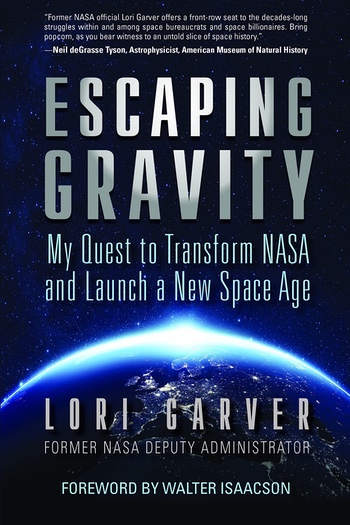Review: Escaping Gravityby Jeff Foust
|
| Garver recalls Bolden mishandling the discussions with the White House on the budget proposal that would call for cancelling Constellation. “The train wreck was now inevitable.” |
That alone would make Escaping Gravity by Lori Garver, NASA deputy administrator from 2009 to 2013, an interesting read by providing an insight into how the agency is run. Garver, though, exceeds expectations with a frank, critical examination of how the agency, as well as stakeholders in the White House, Congress, and industry, reacted to efforts the change the trajectory of the agency while she was second-in-command of the agency. (See also “Escaping Gravity and the struggle to reshape NASA”, The Space Review, June 27, 2022.)
The broad outlines of what happened during her tenure as NASA deputy administrator are well known. After the Augustine Committee in 2009 concluded that the Constellation program was not achievable without a significant increase in funding, the Obama Administration sought to change the agency’s human spaceflight programs by cancelling Constellation and starting the commercial crew program as well as technology development to enable future exploration. After pushback from members of Congress, industry, and even some within NASA, the administration and NASA settled on a compromise that allowed commercial crew to proceed but also some of the cornerstones of Constellation, the Orion spacecraft and the Space Launch System.
What Garver does is fill in the details within the broad outlines that were not widely known outside NASA. The book is full of anecdotes and other information about the development of that policy, far more than can be summarized in a review. Suffice it to say, no matter how well you think you know how NASA operated in that era, you will learn a lot from the book as Garver recalls the debates, disagreements, and disputes that shaped policy and NASA’s implementation of it.
Some people in the book do not come off well in Garver’s recounting of events. Among them is Charlie Bolden, NASA administrator when she was deputy. He comes off in the book as not just reluctant to support aspects of the administration’s plan but also mishandling the discussions with the White House on the 2011 budget proposal being drafted in late 2009, one that would call for cancelling Constellation. “The train wreck was now inevitable,” she writes.
“I viewed Charlie’s opposition to administration policies as peculiar,” she writes, stating that, in most agencies, the political leadership is aligned with the White House. She also raised ethics concerns, including how Bolden blocked funding for an aviation biofuel project at NASA Ames based on comments he said he got from Marathon Oil, a company he previously served on the board of—a conflict of interest violation eventually flagged by the agency’s inspector general.
By contrast, Garver praises Dan Goldin, a divisive figure who was administrator in her first stint at NASA in the 1990s working policy and strategy issues. She credits him as much for pushing NASA to adopt commercial practices as for his famous “faster, better, cheaper” philosophy. “Dan worked tirelessly to advance the status quo, advance innovation, and transition NASA into the twenty-first century,” she writes.
| “Dan [Goldin] worked tirelessly to advance the status quo, advance innovation, and transition NASA into the twenty-first century,” she writes. |
If there is an overarching theme in the book, it is a battle for the soul of NASA between what she calls “space pirates” and “cup boys.” The space pirates were space advocates who, for decades, had been trying to create a spacefaring civilization that they argued traditional approaches were not achieving, seeking to cut launch costs and support commercial initiatives. The cup boys, by contrast, were defenders of the status quo within NASA and industry: the name, she described, comes from the cups these ex-military men would have emblazoned with their callsigns. Garver is clearly on the side of the space pirates as she sought to advance efforts like commercial crew, working around the obstacles posed by the cup boys.
The space pirates appear to have won: commercial crew is a success, with SpaceX entrusted by NASA to transport astronauts to and from the space station and Boeing finally on the path to do the same. NASA has adopted that commercial model for lunar landers, spacesuits, and space stations that will succeed the ISS.
Garver notes that Bill Nelson, who as a senator was initially, at best, a skeptic of commercial crew—Garver recalls Nelson telling her in one meeting to “get your boy Elon in line”—later took credit for it through his backing of the 2010 bill that authorized the program along with SLS. (Just a couple months ago, though, Nelson, now the NASA administrator, decried the “plague” of cost-plus contracts at the agency, sounding a little something like a space pirate.)
Escaping Gravity is an eye-opening book about her experiences at NASA—good and bad—and the efforts to change the course of NASA. Anyone with an interest in space policy will learn a lot about how things really get done, or don’t get done, particularly when those seeking change battle entrenched interests.
Note: we are using a new commenting system, which may require you to create a new account.
